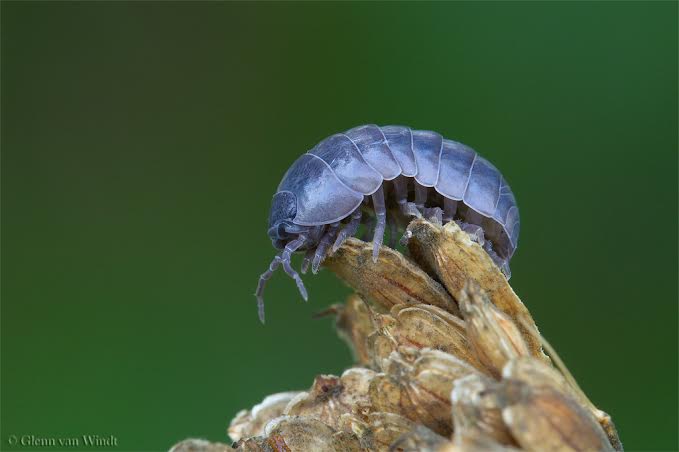Interesting Facts about A.vulgare
Unique special abilities:
Pillbugs are often confused with Sowbugs, however there are a
few important differences between the two organisms. Sowbugs
have two appendages on the posterior end of their bodies. These
tail-like appendages are not present in pillbugs. Pillbugs, on
the other hand, can roll into a ball when they perceive a
threatening stimuli. Sowbugs are not able to induce this
defense strategy (Potter 2010).
Seasonal climbing:
A.vulgare changes feeding habits according to seasons,
and will strategically choose feeding locations to make the most
of their time outside of their dark homes. During winter
months when many  plants are dead mush on the ground and leaves
remaining on living plants are green, the organism will remain
on the floor of its habitat to seek food. However, during
summer months when leaves at the top of plants are dry and
there's less dead plant matter on the forest floor, A.
vulgare will climb plants for food (Paris 1963).
plants are dead mush on the ground and leaves
remaining on living plants are green, the organism will remain
on the floor of its habitat to seek food. However, during
summer months when leaves at the top of plants are dry and
there's less dead plant matter on the forest floor, A.
vulgare will climb plants for food (Paris 1963).
More like a crab than an insect?:
Many commonly mistake A. vulgare for an insect, but in
reality they are crustaceans. Crustacea is a subphylum under
the phylum Arthropoda that includes approximately 30,000 different
species, including
crabs,
shrimp, and
lobsters
(a number of different crustaceans may be observed in the image to
the right). They are characterized by a number of different traits;
a few of these traits are two sets of antennae, compound eyes, gills
for respiration, and pairs of appendages on each body segment
(Animal Diversity 1999).
 The
mysterious blue Armadillidium vulgare:
The
mysterious blue Armadillidium vulgare:
It is not uncommon to encounter a blue A.vulgare
while trekking through the woods, especially in their Japanese
habitats. However, contrary to popular thought, these little
blue guys are not a rare find with mutations in their genes to make
them appear blue, and they certainly do not have any special
abilities! When infected by a virus within the genus Iridiovirus,
A. vulgare's DNA becomes infected and their outer
pigmentation is altered and appears to be a blue-violet color.
The virus also causes decreased responsiveness to water and light,
thus shortening the lifespans of the infected organisms
significantly (Karasawa et al. 2012). As is described in
both the Form and Function and
Habitat pages, A.vulgare
depends upon its photoreceptors to judge how long it can be in a
certain amount of light without losing too much internal water due
to its lack of a cuticle layer that most other terrestrial organisms
possess.
Evaporation instead of urination:
Interestingly enough, A. vulgare does not urinate at all.
Most organisms must convert high ammonia levels from waste into urea
before passing it out of the body via urination. Roly poly
bugs, however, have a high tolerance for ammonia and can simply pass
liquid waste directly through their exoskeletons to dispose of them
(Animal Diversity 1999).
Love the skin you’re in:
After the A. vulgare undergo a molt, they eat the recently
shed skin. This is because the exoskeleton is full of calcium
that will go into the formation of their new exoskeleton (Woodland
Park Zoo 2013).
Feeling blue:
Human blood contains a chemical called hemoglobin that
carries the oxygen. Hemoglobin contains iron so it takes on a
red color. The blood of the A. vulgare uses a
chemical called hemocyanin which contains copper instead of iron.
This gives it a blue color rather than red (Raham 1986).
Cannibalism:
The A. vulgare has been observed performing acts of
cannibalism. In these cases the culprits are usually adult A.
vulgare feeding on the newly born individuals. In most cases,
the individuals being fed upon are previously deceased. Rest
assured that the A. vulgare may be cannibals, but they are
certainly not murderers (Paris 1963).
A delicacy:
Though it may not make sense to human beings, the A. vulgare
eat their own feces. This process, called coprophagy, is
completed in order to extract any copper (and other nutrients) not
taken out during its first time through the digestive system.
The digestive system of the A. vulgare is relatively
simple; it is basically a straight tube connecting the mouth and
anus. Feces make up approximately nine percent of the A.
vulgare’s diet (Raham 1986).
The authors' personal experiences and other
things to note:
We chose to do our project on the Armadillidium vulgare because
we both remember coming across these adorable little guys very
often while digging in the dirt when we were little. These
non-creepy bugs were one of the very few outside creatures who
did not give us the heebie-jeebies. Because we have such fond
memories of the pillbugs, we decided we wanted to learn more
about them. Pillbugs are important to the world because of they
play an important role in many ecosystems around the world as
decomposers. They are also used in
forensic entomology to solve murders. Check out our other
pages to get more information on these cool creatures!
Return to Home Discover more on our References page

